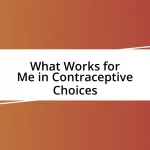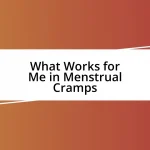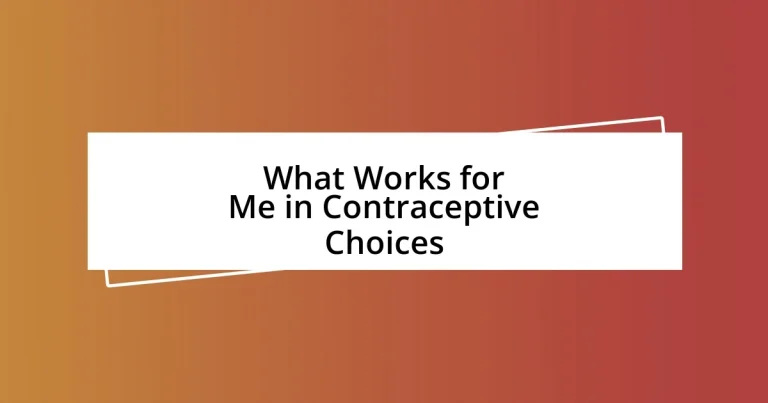Key takeaways:
- The effectiveness and reliability of contraceptive methods vary, and personal lifestyle plays a crucial role in determining what works best.
- Health factors, such as family history and current medications, are essential to consider when choosing a contraceptive method to ensure safety and compatibility.
- Engaging in open discussions with partners and utilizing technology can facilitate informed decision-making and strengthen mutual understanding in contraceptive choices.
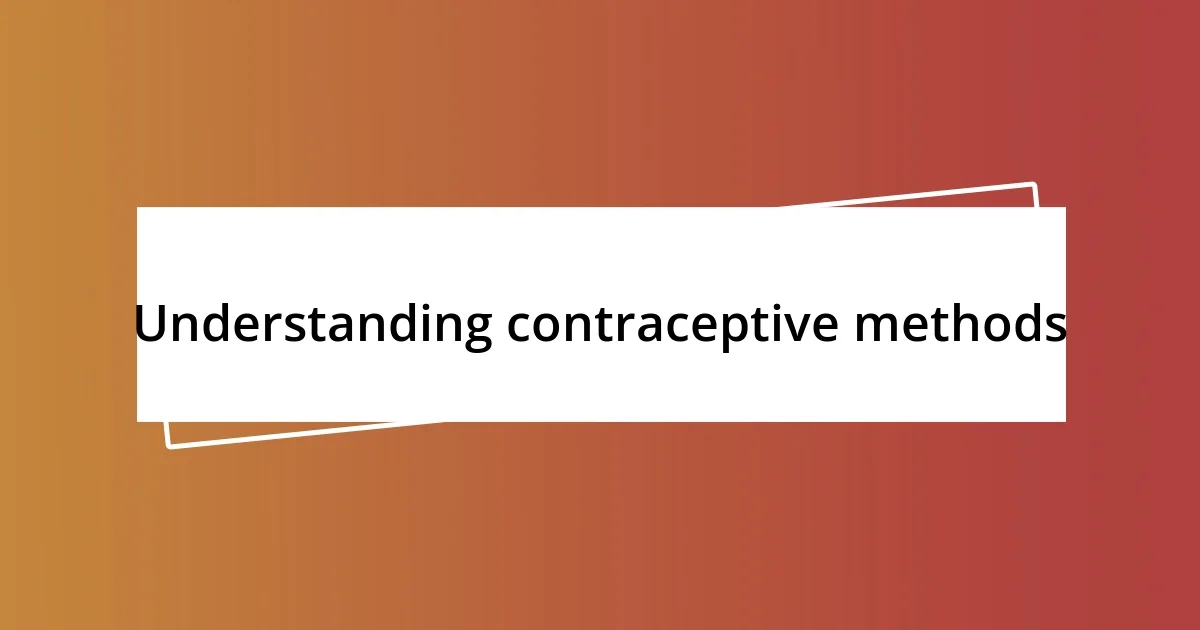
Understanding contraceptive methods
Understanding contraceptive methods can feel overwhelming, but it’s vital to find the right one for you. I remember when I first started exploring these options; I felt a mix of curiosity and anxiety. It’s easy to get lost in the various choices—pills, IUDs, condoms, and more—each method having its own benefits and considerations. Have you ever felt that pressure to choose the “perfect” method?
It’s essential to understand how each contraceptive method works. For instance, hormonal methods like the pill or patch can regulate your cycle and provide effective pregnancy prevention by altering hormone levels in your body. I spoke with friends who had different experiences with these methods—some loved how easy they were, while others felt side effects that turned them away. So, it’s not just about effectiveness; it’s about how your body responds and what fits your lifestyle.
Then there are barrier methods, which serve a dual purpose by also reducing the risk of sexually transmitted infections. Using condoms, for instance, can bring a sense of security and empowerment. I recall trying different brands to find the right comfort and fit, and sometimes feeling a little shy about it. Isn’t it funny how something so crucial can also be a bit awkward? Ultimately, it’s all about knowing yourself and what makes you feel safe and in control.
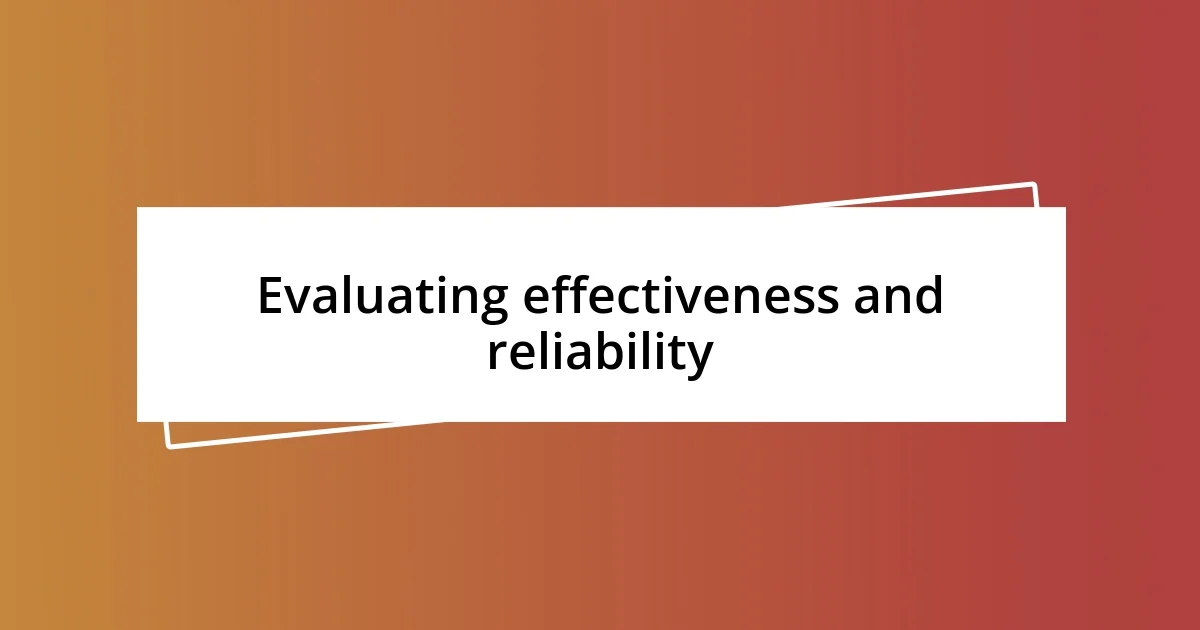
Evaluating effectiveness and reliability
Evaluating the effectiveness and reliability of contraceptive methods is crucial for anyone exploring their options. Each method has its own success rate in preventing pregnancy, which can vary widely. For example, I remember deciding to use an IUD after learning it has a failure rate of less than 1%. That kind of reliability gave me peace of mind—it’s almost like having a safety net. Have you ever felt that sense of security in a choice you’ve made?
When considering effectiveness, it’s also essential to think about how consistently you can use each method. I tried oral contraceptives for a month, but my busy schedule led to missed doses and, ultimately, frustration. It really hit home how the effectiveness of a method isn’t just about its statistics; it’s about how well it fits into your lifestyle. How do you manage daily routines, and would a method that requires less day-to-day attention be more suitable for you?
Understanding these nuances can make a world of difference. I often found myself discussing my choices with friends, and we would share stories about what worked and what didn’t. Their experiences helped me evaluate different methods better. The conversations highlighted that reliability often ties to personal preference and habitual use, not just the data alone; it’s a blend of what works scientifically and what works for you emotionally.
| Method | Effectiveness Rate |
|---|---|
| Implant | 99% |
| IUD | 99% |
| Pill | 91% |
| Condom | 85% |

Considering personal health factors
Considering personal health factors is a crucial step in choosing the right contraceptive method. I recall when I first considered the impact of my own medical history—being aware of my family’s health issues, like high blood pressure, made me rethink certain hormonal methods. It hit me that my choices had to align not just with my lifestyle, but also with my overall health in order to be truly effective and safe.
When weighing your options, it’s important to take note of specific health factors that might influence your decision. Here are a few to keep in mind:
- Family health history: Conditions like diabetes or blood clots can affect eligibility for hormonal methods.
- Current medications: Some contraceptives may interact with your existing prescriptions, so checking with a healthcare provider is pivotal.
- Menstrual cycle regularity: Understanding your cycle can help in selecting methods that either regulate or manage your symptoms effectively.
- Allergic reactions: Some women might be allergic to certain materials in barrier methods, making it essential to test compatibility.
My experience taught me that the more I learned about how different methods affect my body, the more confident I became in my decisions. It wasn’t just about picking an option; it was about making an informed choice, one that respected my unique health profile.

Exploring hormonal options available
Hormonal contraceptive options can feel overwhelming at first, but each method offers unique benefits that cater to different lifestyles. I found the birth control patch particularly interesting because of its ease of use—I just applied it once a week. It was a game changer for me, allowing me to avoid the daily reminders that came with the pill. Have you ever tried a method that felt like it clicked perfectly with your routine?
Then there’s the hormonal IUD, which absolutely fascinated me when I learned how it works. It releases hormones locally, reducing the risk of pregnancies while requiring minimal maintenance. After my experience with the pill, I craved something more long-lasting and reliable. The prospect of having up to five years of peace of mind felt incredibly liberating, didn’t it?
Another option that’s worth considering is the birth control implant. I can still remember my initial hesitation about getting it inserted because I thought it might be painful. However, the thought of not worrying about contraception for three years after just a quick appointment changed my perspective. Honestly, that sense of freedom was worth any initial discomfort. Isn’t it intriguing how our perceptions can shift as we gain more knowledge about our choices?

Reviewing non-hormonal alternatives
Exploring non-hormonal contraceptive options can open up a world of choices that align with personal preferences and health considerations. I remember the first time I learned about the copper IUD—it was like discovering an entirely new realm of possibilities. It’s a non-hormonal option that offers up to ten years of effective pregnancy prevention without altering my body’s natural hormone levels. The idea of something being so low-maintenance yet reliable completely intrigued me.
Then there are barrier methods like condoms, which I’ve always appreciated for their accessibility and dual protection against sexually transmitted infections. I once had a conversation with a friend who highlighted how using condoms actually helped her feel more empowered in her sexual choices. It’s remarkable how a simple tool can promote a sense of control, isn’t it? Plus, the added benefit of spontaneity without hormonal side effects makes them appealing to many.
I can’t overlook the option of fertility awareness, which I personally found fascinating to explore. Tracking my cycle taught me so much about my own body—the nuances of ovulation, and the way natural rhythms can guide decision-making. It was a game-changer for me, giving me a sense of connection to my health that I hadn’t felt before. Have you ever reflected on how understanding your body’s signals could empower you to choose a method that truly resonates with you?
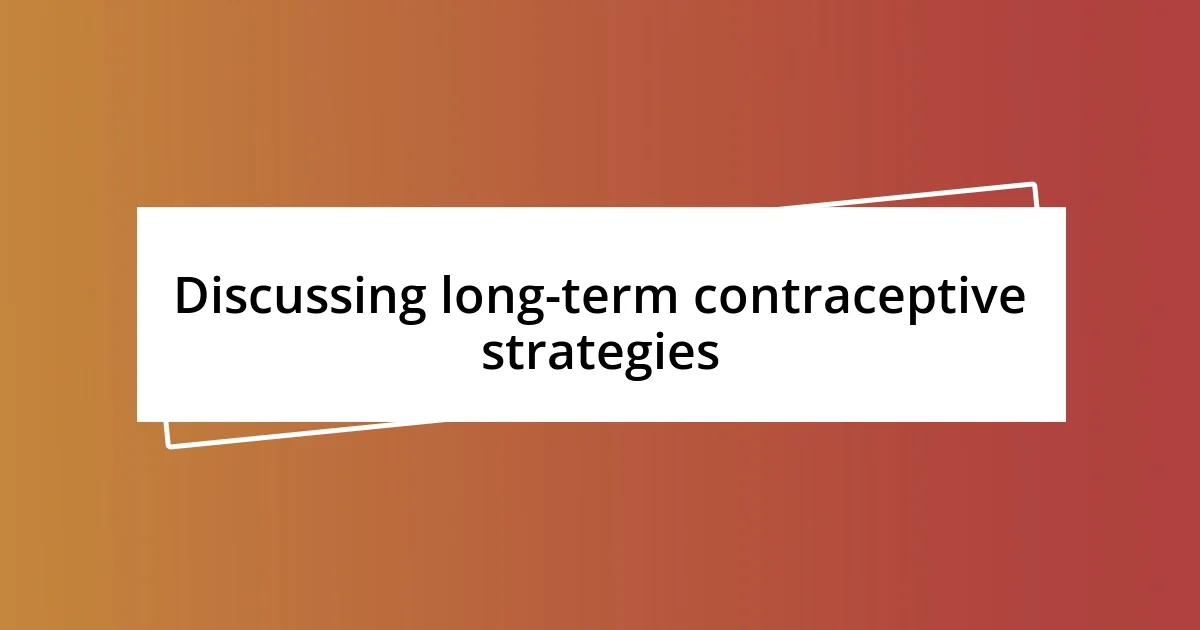
Discussing long-term contraceptive strategies
Long-term contraceptive strategies can significantly shape how we approach family planning. I vividly recall my decision to switch to a hormonal IUD. The thought of a five-year commitment felt daunting initially, but I soon realized how liberating it was not to think about contraception daily. Have you ever felt that rush of relief when a decision aligns perfectly with your needs?
Another long-term option gaining traction is the contraceptive implant. When I first considered it, I grappled with the idea of having something in my arm for three years. But I remember the day I got it; it was quick, and the peace of mind that followed was extraordinary. That moment of hesitation transformed into empowerment, reminding me that sometimes, facing fears can lead to rewarding experiences.
Then there’s the copper IUD, which I found compelling due to its non-hormonal nature. I was in awe of how it could offer protection for up to ten years without affecting my natural hormone levels. It made me reflect on how diverse our choices can be in pursuing what feels right for our bodies. Have you ever thought about how empowering it is to take charge of your reproductive health with such options?

Making informed decisions together
Making informed decisions about contraception isn’t just about reviewing options; it’s about engaging in a dialogue with your partner. I remember the deep conversations I had with my partner during my own decision-making process. It felt good sharing our thoughts and concerns openly—it brought us closer and assured me that we were both on the same page. Have you ever thought about how sharing these discussions can ease the pressure of decision-making?
One evening, as we sat on the couch, my partner mentioned how overwhelmed they felt by all the information out there. It was a lightbulb moment for me. I realized that what worked for us wasn’t just about choosing a method; it was understanding each other’s values and concerns. I encourage couples to set aside time for these conversations, actively listen to each other, and explore each other’s feelings and needs together. When both partners feel heard, the decision becomes much more manageable and less intimidating.
I also recall a moment when my partner suggested using an app to track our discussions and preferences. It turned out to be a game-changer! Not only did it help us visualize our options, but it also sparked interesting debates that deepened our understanding of what each method entailed. Have you considered how technology might aid your conversations about contraceptive choices? Embracing these tools can turn a daunting process into a shared journey filled with learning and growth.

